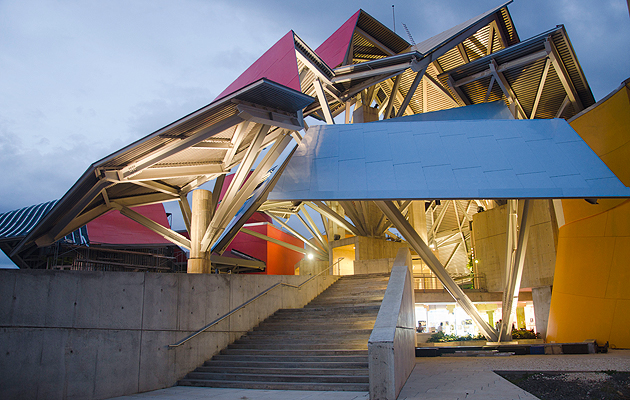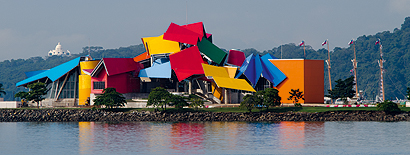|
An elaborate steel structure supports the canopies (Images: Victoria Murillo/IstmoPhoto.com) |
||
|
Frank Gehry marks his first project in Latin America with a multicoloured collision of canopies on the banks of the Panama Canal After a grinding construction process lasting over a decade, the final parts of the Biomuseo, designed by Frank Gehry, are coming together. This riotous crash of multicoloured panels sits on the edge of the Amador Causeway, a former US military site on the outskirts of Panama City, with a prime view over the southern entrance to the Panama Canal. An attempt to put Panama City on the architectural map, it is the first Latin American building designed by the octogenarian architect and represents a more tropical version of his signature design language. The building is what used to be called a natural history museum, and incorporates various galleries with exhibitions relating to the biodiversity of the Isthmus of Panama, which fully emerged from the ocean 3 million years ago. This geological event created a bridge between the American continents, altered the climate of the Atlantic and Pacific regions, and thus influenced the evolutionary history of the whole planet. The eight galleries are generally orthogonal and useful, with the exhibitions designed by Bruce Mau, and they are arranged around a central open atrium. The usual museum programme of cafes and gift shops is housed alongside. The Gehry magic is primarily concentrated into the canopies above, which are tinted primary colours and play the architect’s favoured game of presenting a formally perfect exterior, then revealing all of the construction guts as the visitor steps inside the perimeter. It is somewhere between the Bilbao Guggenheim and the Marqués de Riscal Winery in Rioja, with the formal extravagance toned down just a little. There are limited complex curvatures, but plenty of folded planes, which set off against each other in the old-fashioned Gehry collage-style. The story of the project as a whole is similar to many cultural buildings of the late 1990s. Gehry, whose wife is from Panama, had taken part in a conference discussing potential uses for the site, and then was invited by the Fundación Amador, the client, to work up a serious proposal for the museum. Design work started in 2002, and the building was on site by 2005. But since then, construction has been very slow: fundraising was difficult, there have been changes of political administration and the local construction industry found it very difficult to adapt to the particular challenges of the Gehry design method. Once again, a building conceived in a pre-2008 world of conveyor-belt cultural attractions is emerging into a changed environment, but the client is hopeful that the building will be a cultural and touristic boon for Panama City. Not everyone is impressed by the Biomuseo. American writer Geoff Manaugh delivered a rather uncharacteristic attack for the tech blog Gizmodo, describing the building as proof that Gehry “is still the world’s worst living architect”. Whether or not you have patience for the spectacular museum building any more, the Biomuseo shows Gehry can deliver for slightly less gilded clients. And there’s always the Guggenheim Abu Dhabi to come …
The coloured canopies are made of folded steel |
Words Douglas Murphy |
|
|
||


















